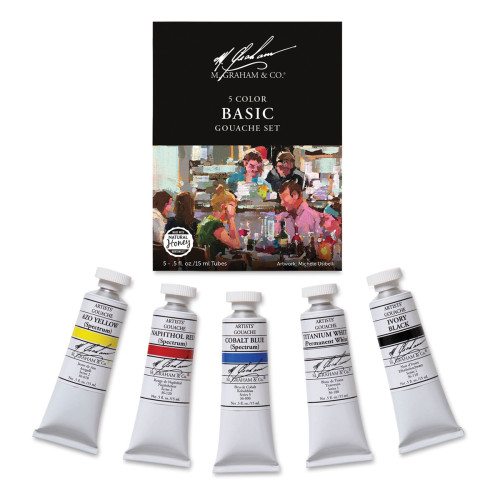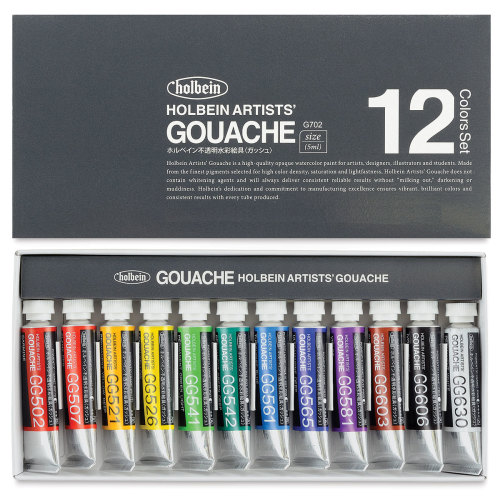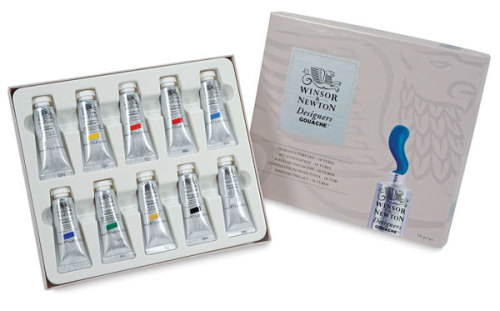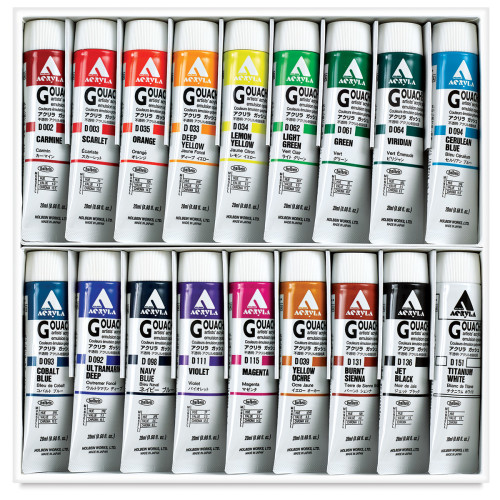Gouache paint is a type of opaque, matte watercolor paint. It is made by adding gum arabic to colour pigments. It has a thicker, more viscous consistency than regular watercolour paint, which is due to the increased ratio of pigment to binder. However some paint manufacturers add either white pigment or inert white fillers like chalk to increase the opacity of the paint.
What sets gouache apart from watercolour is the addition of opaque white. The opacity of the paint allows artists to layer highlights on top of darker layers and build colour on the surface. Gouache is easy to learn for beginner artists; painters often use the medium in mixed media applications, such as alongside watercolour or pastel.
Disclaimer: Fine Art Tutorials is a reader supported site. When you make purchases through links on this site, we may earn a small commission at no extra cost to you.
How do you pronounce gouache?
Pronounce gouache “gwash”, or “goo-ash”.
The word “gouache” comes from the Italian guazzo, meaning “mud.” This name originally applied to the technique of painting with tempera over oil paint in the 16th century, which was used in order to achieve a matte effect. However, the French started using the word in the 18th century to describe the opaque water-based media we use today. It was not until the 18th century that gouache became a popular painting medium in Europe.
What do gouache paintings look like?

Gouache dries to a matte finish. The pigments are opaque and colours can appear slightly different in value when wet compared to when dry.
Because gouache is a low viscosity medium, it’s not possible to achieve texture with it in the same way as with thicker paints like oil or acrylic. However, colours appear vibrant in the paper, so the result is a flat and bright appearance.
Gouache is a versatile medium that artists use for both traditional painting and more experimental techniques.
The matte finish makes gouache the perfect medium for illustrators and graphic artists who want to scan their paintings and reproduce them digitally, without worrying about glare or reflections on the paint film.
What is the difference between gouache and watercolour?
The main difference between gouache and watercolour is that gouache is an opaque medium, while watercolour is a transparent medium. This means that you can build up layers of colour with gouache, whereas with watercolour, each layer will darken the layers beneath. Use opaque white gouache paint to create highlights on top of darker tones.
Similar to watercolour paint, gouache is water soluble and artists can reactivate it once dry. This means that painters can take a wet brush to lift colour from the page.
When was gouache paint invented?

Gouache paint has been used by artists for centuries. It was first used by the Egyptians. In the 18th century, it became popular among portrait painters and was commonly used by French and British artists. By the 19th century, gouache was widely used by artists of all genres.
Gouache was commonly used by 19th-century artists such as Picasso, John Singer Sargent, Edgar Degas and Anders Zorn. Singer Sargent used gouache as highlights in his watercolour paintings.

Gouache fell out of favour in the early 20th century with the advent of Modernism. However, it experienced a resurgence in popularity in the late 20th century and is now used by many contemporary artists.
Despite its long history, gouache paint is still popular among artists today. Its thick consistency allows for opaque and vibrant colours. And because it can be used on a variety of surfaces, it is a versatile medium that can be used for a wide range of artworks.
How do you paint with gouache?
Gouache paint can be used with a variety of painting techniques. Once you have your supplies, mix your gouache paint with water to create the desired consistency. If you want a more opaque effect, use less water. For a transparent effect, use more water. When mixing your paint, use a palette knife in order to keep brushes clean.
Get a basic palette of colours, including titanium white and the primary colours, so that you can mix other tones and values. Some great colours to get to make a primary palette are phthalo blue, magenta and primary yellow. Some other colours artists use to mix a greater range of tones include ultramarine blue and cadmium red. Make sure to grab a tube that will deepen colours in an artwork, such as burnt umber or ivory black.
To paint with gouache, start by sketching your design onto your painting surface. Then, wet your brush and load it up with paint. Paint in the mid tones and lightest areas first and then build up to the darker areas. You can layer colours on top of each other to create different effects. Remember to allow each layer to dry before adding the next.
What are the benefits of gouache painting?
Gouache paint has many benefits. It’s easy to transport, clean and doesn’t require many materials to get started with painting. Because it’s so easy to transport, artists favour this medium for plein air painting. It’s a great one to pack if you’re planning on travelling with some art supplies.
Gouache is also a versatile medium that can be used for a variety of painting techniques. Painters use the basic watercolour techniques with gouache, such as washes, dry brushing and more.
Another benefit of gouache paint is that it dries quickly. This means that you can work on your painting in short bursts and don’t have to worry about the paint drying out before you’re finished. Gouache is also easy to store and doesn’t require specialised equipment.
So if you’re looking for a fun and easy way to get into painting, give gouache a try! You might be surprised at how much you enjoy it.
How is gouache paint made?
Gouache paint is made by mixing pigment with a binding agent, such as gum arabic. The mixture is then made into cakes or tubes of paint.
The pigment to binder ratio can vary depending on the brand of gouache and the desired consistency. More pigment will produce a more opaque paint, while less pigment will produce a more transparent paint.
What are the different types of gouache paint?
Gouache paint comes in a variety of formulations, including student-grade and artist-grade. Student-grade gouache is typically made with lower-quality pigments and binders. This makes it less expensive but also less durable and less vibrant. Artist-grade gouache is made with higher-quality pigments and binders. This makes it more expensive but also more durable and more vibrant.
What are the best brands of gouache paint?
The best brands of gouache paint are those that use high-quality pigments and binders. Some of the best-known brands include M. Graham & Co., Winsor & Newton, and Schmincke.
M. Graham gouache paint

M. Graham is widely considered to be one of the best brands on the market. Their gouache paint is made with high-quality pigments and binders. It is also lightfast and highly pigmented. M Graham gouache paint is available in a variety of colours, including traditional and non-traditional shades. It’s a professional quality paint, used by a number of high profile artists.
Holbein gouache paint

Holbein is another high-quality gouache paint brand. They are a Japanese brand that manufactures intensely pigmented, professional quality paints.
Their gouache paint is made with pure pigments and has a high pigment load, so the paints will appear vibrant on the paper. Expect high coverage from Holbein paint, this brand creates opacity by adding Chinese white to the pigments.
Holbein gouache paint is also lightfast and considered to be professional quality. The finish is velvety and matte, which makes it perfect for a variety of fine art applications and illustration work.
Winsor & Newton gouache paint

Winsor & Newton is a well-known brand that produces a variety of high-quality art supplies. Their gouache paint is made with artist-grade pigments and binders. It is lightfast and has excellent coverage. The Winsor & Newton art supplies are slightly cheaper than M. Graham and cheaper than Holbein, however, they deliver excellent quality for the money.
What supplies can you use with gouache?
To start painting with gouache, you will need a few supplies. First, you will need a palette for mixing your paints. A porcelain palette is ideal, but any non-porous surface will work. This Mijello plastic palette is sealable and has a large space for mixing. It keeps colours squeezed from the tube wet for days at a time.
When purchasing gouache paint, it is important to buy artist-grade paint, as this will provide the best results. Our top picks are M. Graham, Holbein, Schmincke and Winsor & Newton.
Gouache paint can be used on a variety of surfaces, such as watercolour paper, Aquabord and even watercolour canvas. To learn how to paint on watercolour canvas, check out our guide.
You will also need a selection of gouache brushes, including round and flat brushes. Sable and synthetic sable brushes work wonderfully with gouache. Paint brushes should be soft and absorbent, with the ability to hold the low viscosity paint in the bristles. Round sable brushes are great for creating fine details as they taper to a fine point. However, since gouache is slightly thicker than watercolour paint, you can use springier synthetic brushes with paint straight from the tube. Make sure to get a larger flat brush, as these are great for covering large areas of paper quickly.
Read more about the supplies you need for gouache painting in our comprehensive guide.
Gouache painting techniques
Artists have the flexibility of treating gouache like regular watercolour paint by thinning gouache in washes of water.
Another approach to gouache painting is painting straight from the tube. Gouache paint is thick in consistency, straight from the tube, the colour appears as a bright paste. This enables artists to build thicker colour layers on the paper.
Many artists will start with washes of colour, then build up thicker layers as the painting progresses.
Try the dry brush technique, by dipping your brush in some colour, then removing excess water on a paper towel. Brush over your paper surface, making sure the brush is relatively dry. It will pick up the texture of the paper, giving the impression of texture. This technique is especially useful for gouache landscape painting, to create the impression of distant trees or rocks.
What is acrylic gouache paint?

Acrylic gouache is a type of paint that combines the properties of gouache and acrylic paint. It has the creamy consistency of gouache and dries to a matte finish. However unlike regular gouache, it dries to a water-resistant film like acrylic paint. This means that it is not reweattable when dry.
Holbein make a great range of acrylic gouache, which is fast drying, matte, water-resistant. Their colours provide smooth, even opaque coverage on a number of surfaces.
Acrylic gouache is made with pigments suspended in an acrylic resin binder. This makes the paint more durable and resistant to water damage than regular gouache paint.
What are the benefits of acrylic gouache?
The main benefit of acrylic gouache is that it dries to a waterproof film. This makes it ideal for painting outdoors, as you don’t have to worry about your painting getting ruined by rain or splashes of water.
Another benefit of acrylic gouache is that it can be used on a variety of surfaces, such as paper, wood, fabric and even glass.
What are the disadvantages of acrylic gouache?
One disadvantage of acrylic gouache is that it cannot be reworked when dry, unlike regular gouache paint. Once it dries, you will not be able to lift paint or make any changes.
Another disadvantage of acrylic gouache is that it can be difficult to find in art stores. However, it is available online from a variety of retailers. Blick stocks Holbein acrylic gouache and Liquitex acrylic gouache.
Gouache painting tutorials
If you’ve decided that you might like to try painting with gouache, there are lots of awesome tutorials on YouTube and Skillshare to try.
In this Skillshare class, Sarah Burns teaches artists the basics of gouache painting, how to mix colours and walks you through how to paint three landscapes. Sarah is a fantastic, self-taught artist and teacher who explains painting concepts with clarity.
If you’re new to gouache painting, start small! By creating a small series of paintings, you will get to paint a variety of subjects at greater speed, which will encourage you to use a wider variety of techniques. This mini coastal gouache painting is a great place to start.
Looking for more gouache painting ideas? Check out our guide. Find 20 ideas and tutorials by some of the best artists and teachers on YouTube and Skillshare. From seascapes, sunsets, still lifes to portraits and nocturnes; find the perfect paintings to start your very own project.
If you’ve found anything on this site especially useful, you can make a donation to me through PayPal. I take a lot of time to research and write each topic, making sure each tutorial is as detailed as possible and I make all my content freely available. Any small donation (even the price of a cup of coffee!) can help me to cover the running costs of the site. Any help from my readers is much appreciated :).
Follow the link in the button below to support this site.

